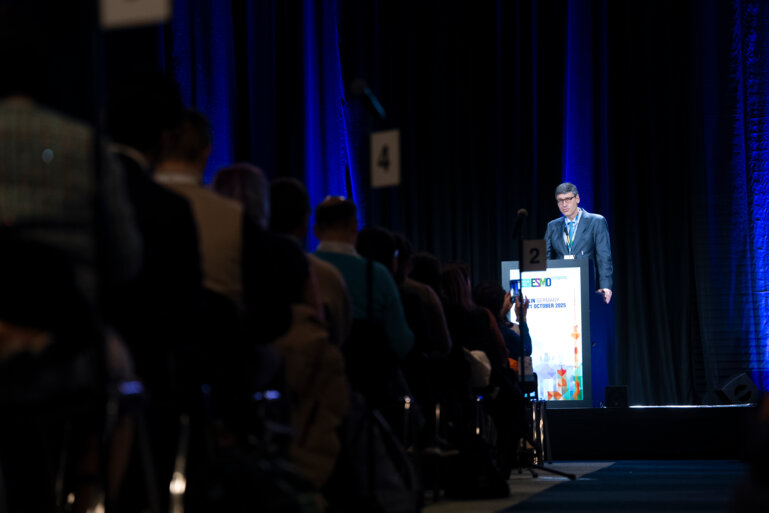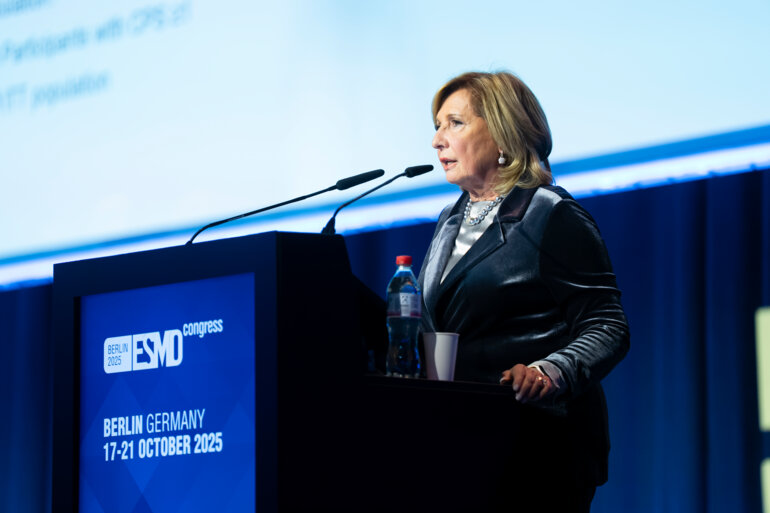Results from the BAROCCO trial may help define the optimum treatment schedule for an antiangiogenic–PARP inhibitor combination in recurrent, platinum-resistant ovarian cancer
Results from the BAROCCO trial presented yesterday may help define the optimum treatment schedule for an antiangiogenic–PARP inhibitor combination in recurrent, platinum-resistant ovarian cancer. Continuous cediranib–olaparib shows a trend towards improved progression-free survival (PFS) compared with standard-of-care weekly paclitaxel in pretreated patients with recurrent ovarian cancer resistant to platinum.
Among 123 patients, a continuous schedule of the antiangiogenic–PARP inhibitor combination was associated with median PFS of 5.7 months, compared with 3.1 months for weekly paclitaxel and 3.8 months for an intermittent schedule of cediranib–olaparib (Abstract LBA58). In the 109 patients with BRCA wild-type disease, median PFS was 5.8 months for continuous cediranib–olaparib, 2.1 months for weekly paclitaxel and 3.8 months for intermittent cediranib–olaparib.
"BRCA mutation-positive disease confers sensitivity to PARP inhibitor therapy,” says Professor Cristiana Sessa from the Oncology Institute of Southern Switzerland (IOSI), Bellinzona, Switzerland, "however, these results suggest that the cediranib–olaparib combination is effective, regardless of whether this mutation is present.” Adverse event-related treatment discontinuations reported in BAROCCO were higher for continuous cediranib–olaparib (18%) than intermittent cediranib–olaparib (7%) or weekly paclitaxel (11%). Such discontinuation rates are not unexpected in these heavily pretreated patients according to Sessa.
"An advantage of this oral combination is that there is added flexibility for pausing therapy to allow recovery, then re-starting therapy again,”, says Sessa. Single-agent olaparib has been shown in previous studies to be as effective as maintenance treatment of newly diagnosed, advanced ovarian cancer harbouring BRCA1/2 mutations, substantially increasing the PFS rate compared with placebo. Now, new data from the phase III SOLO1 trial will be presented at ESMO 2019 in tomorrow’s ‘Poster Discussion – Gynaecological Cancers’ session (10.30 – 11.30, Valencia Auditorium, Hall 5). These will show that maintenance olaparib increases both the time to second disease progression and the time to second subsequent therapy compared with placebo (Abstract 995PD). At 3 years, 75% of patients randomised to olaparib were free from second disease progression.
"Longer survival is the ultimate goal in the treatment of ovarian cancer,” says Sessa, "and this can be achieved not merely by administering different treatments, but also giving them in the right sequence. These results suggest that the benefit of PARP inhibitor therapy could be maintained even after the first disease progression.”
ESMO Congress 2019 abstracts:
- LBA58 - BAROCCO: A randomized phase II study of weekly paclitaxel vs cediranib-olaparib combination given with continuous or intermittent schedule in patients with recurrent platinum resistant ovarian cancer (PROC)
- 995PD - Time to second progression (PFS2) and second subsequent therapy (TSST) for patients (pts) with newly diagnosed, advanced ovarian cancer (OC) and a BRCA mutation (BRCAm) treated with maintenance (mt) olaparib (ola): Phase III SOLO1 trial






